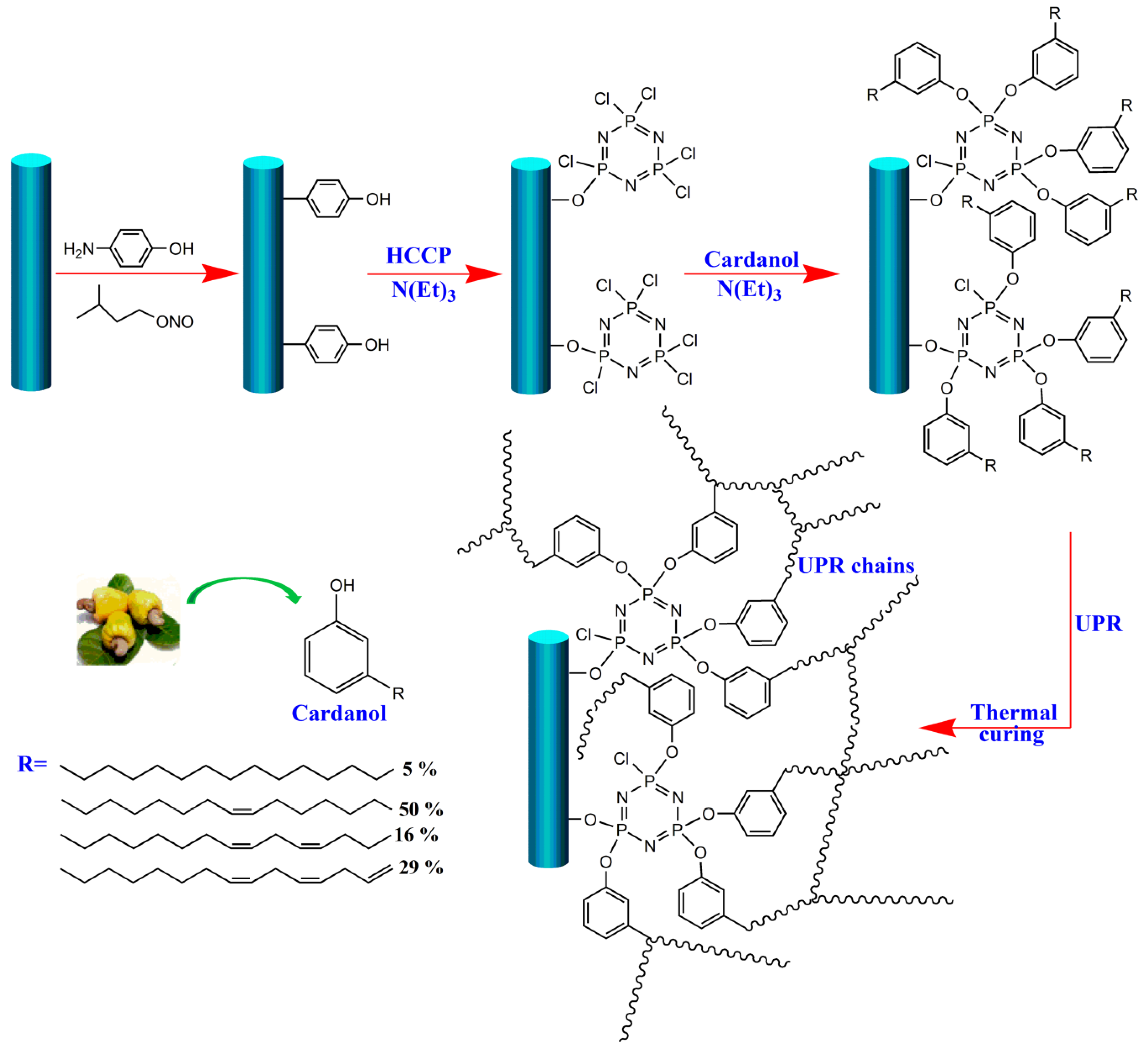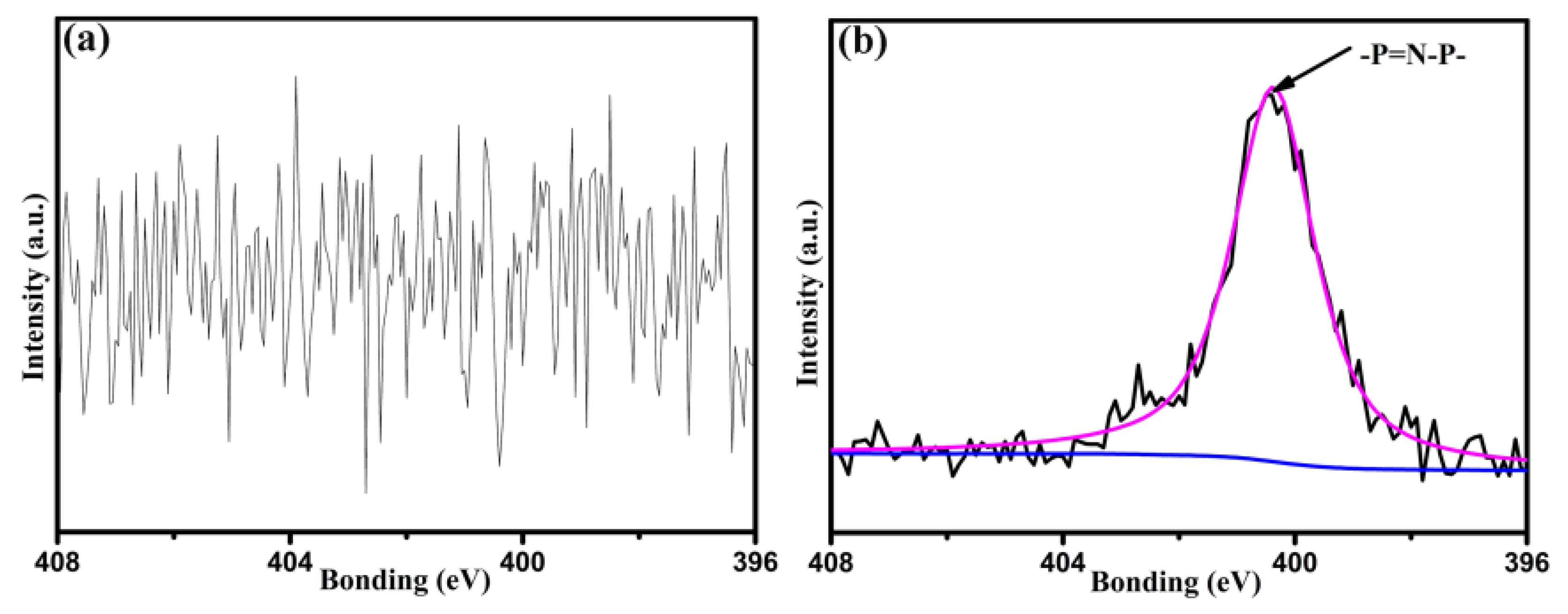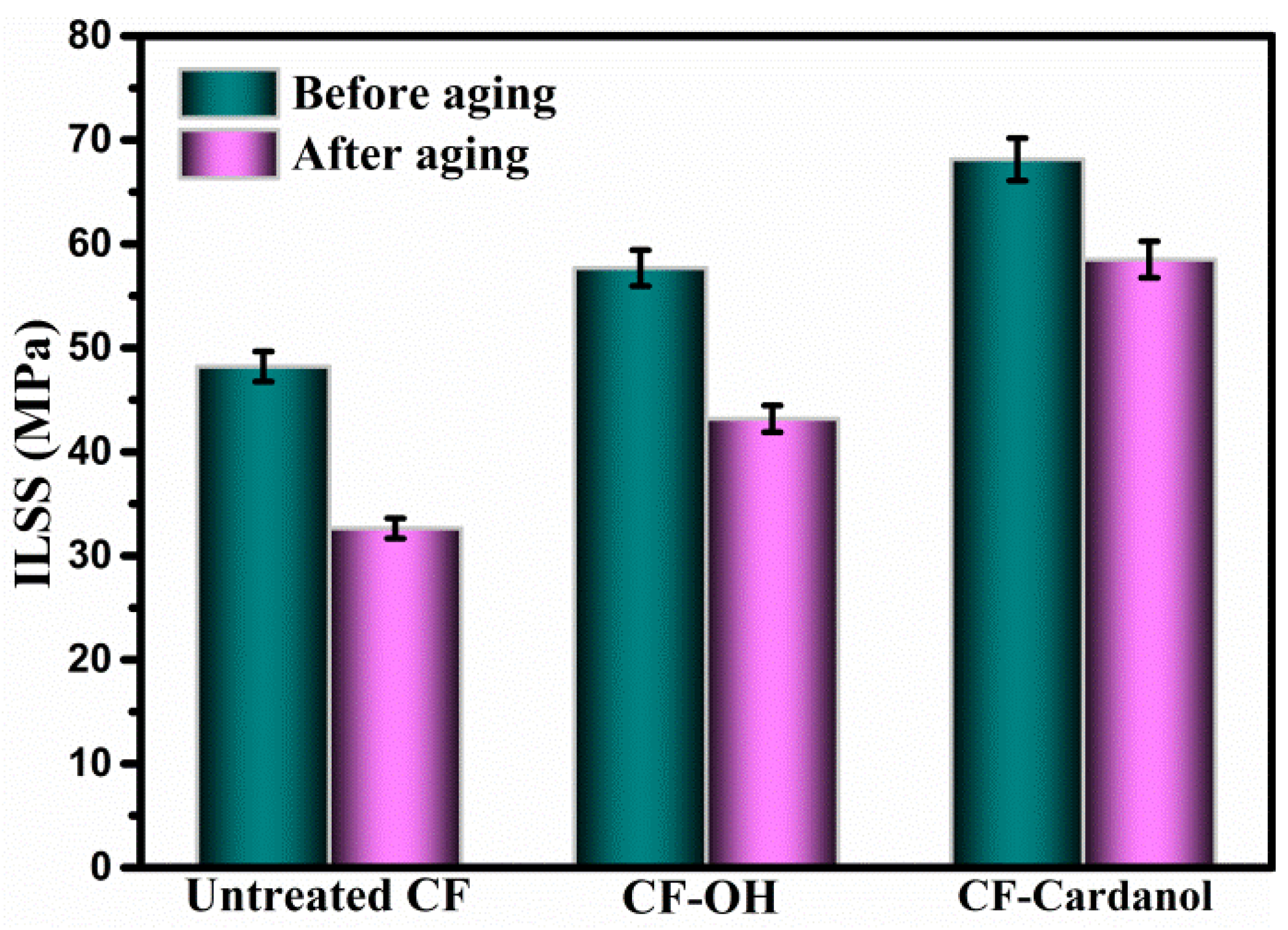Modification of Renewable Cardanol onto Carbon Fiber for the Improved Interfacial Properties of Advanced Polymer Composites
Abstract
1. Introduction
2. Materials and Methods
2.1. Materials
2.2. Fiber Surface Modification
2.3. Preparation of CF/UPR Composites
2.4. Characterization Techniques
3. Results
3.1. Surface Composition and Structure of CFs
3.2. Surface Microstructures of CFs
3.3. Surface Wettability Analysis of CFs
3.4. Interfacial Property Testing of Composites
3.5. Hydrothermal Aging Resistance Testing of Composites
4. Conclusions
Author Contributions
Funding
Acknowledgments
Conflicts of Interest
References
- Bhanuprakash, L.; Parasuram, S.; Varghese, S. Experimental investigation on graphene oxides coated carbon fibre/epoxy hybrid composites: Mechanical and electrical properties. Compos. Sci. Technol. 2019, 179, 134–144. [Google Scholar] [CrossRef]
- Zheng, Y.; Wang, X.; Wu, G. Facile Strategy of Improving Interfacial Strength of Silicone Resin Composites Through Self-Polymerized Polydopamine Followed via the Sol-Gel Growing of Silica Nanoparticles onto Carbon Fiber. Polymers 2019, 11, 1639. [Google Scholar] [CrossRef]
- Lu, C.; Wang, J.; Lu, X.; Zheng, T.; Liu, Y.; Wang, X. Wettability and Interfacial Properties of Carbon Fiber and Poly(ether ether ketone) Fiber Hybrid Composite. ACS Appl. Mater. Interfaces 2019, 11, 31520–31531. [Google Scholar] [CrossRef] [PubMed]
- Wang, C.; Li, J.; Yu, J.; Sun, S.; Li, X.; Xie, F. Grafting of size-controlled graphene oxide sheets onto carbon fiber for reinforcement of carbon fiber/epoxy composite interfacial strength. Compos. A 2017, 101, 511–520. [Google Scholar] [CrossRef]
- Ma, L.; Li, N.; Wu, G.; Song, G.; Li, X.; Han, P. Interfacial enhancement of carbon fiber composites by growing TiO2 nanowires onto amine-based functionalized carbon fiber surface in supercritical water. Appl. Surf. Sci. 2018, 433, 560–567. [Google Scholar] [CrossRef]
- Yao, T.T.; Liu, Y.T.; Zhu, H.; Zhang, X.F.; Wu, G.P. Controlling of resin impregnation and interfacial adhesion in carbon fiber/polycarbonate composites by a spray-coating of polymer on carbon fibers. Compos. Sci. Technol. 2019, 182, 107763. [Google Scholar] [CrossRef]
- Li, N.; Yang, X.; Bao, F.; Pan, Y.; Wang, C.; Chen, B. Improved Mechanical Properties of Copoly(Phthalazinone Ether Sulphone)s Composites Reinforced by Multiscale Carbon Fibre/Graphene Oxide Reinforcements: A Step Closer to Industrial Production. Polymers 2019, 11, 237. [Google Scholar] [CrossRef]
- Chu, C.; Heyi, G.; Gu, N.; Zhang, K.; Jin, C. Interfacial microstructure and mechanical properties of carbon fiber composite modified with carbon dots. Compos. Sci. Technol. 2019, 184, 107856. [Google Scholar] [CrossRef]
- Wu, G.; Chen, L.; Liu, L. Effects of silanization and silica enrichment of carbon fibers on interfacial properties of methylphenylsilicone resin composites. Compos. A 2017, 98, 159–165. [Google Scholar] [CrossRef]
- Zhang, T.; Song, Y.; Zhao, Y.; Zhang, B. Effect of hybrid sizing with nano-SiO2 on the interfacial adhesion of carbon fibers/nylon 6 composites. Colloids Surf. A 2018, 553, 125–133. [Google Scholar] [CrossRef]
- Ma, L.; Wu, G.; Zhao, M.; Li, X.; Han, P.; Song, G. Modification of Carbon Fibers Surfaces With Polyetheramines: The Role of Interphase Microstructure on Adhesion Properties of CF/Epoxy Composites. Polym. Compos. 2018, 39, E2346–E2355. [Google Scholar] [CrossRef]
- Moosburger-Will, J.; Bauer, M.; Laukmanis, E.; Horny, R.; Wetjen, D.; Manske, T. Interaction between carbon fibers and polymer sizing: Influence of fiber surface chemistry and sizing reactivity. Appl. Surf. Sci. 2018, 439, 305–312. [Google Scholar] [CrossRef]
- Cui, X.; Liu, J.; Liu, H.; Wu, G. Enhanced interfacial strength and mechanical properties of carbon fiber composites by introducing functionalized silica nanoparticles into the interface. J. Adhes. Sci. Technol. 2019, 33, 479–492. [Google Scholar] [CrossRef]
- Lee, E.S.; Lee, C.H.; Chun, Y.S.; Han, C.J.; Lim, D.S. Effect of hydrogen plasma-mediated surface modification of carbon fibers on the mechanical properties of carbon-fiber-reinforced polyetherimide composites. Compos. B 2017, 116, 451–458. [Google Scholar] [CrossRef]
- Ma, L.; Zhu, Y.; Feng, P.; Song, G.; Huang, Y.; Liu, H. Reinforcing carbon fiber epoxy composites with triazine derivatives functionalized graphene oxide modified sizing agent. Compos. B 2019, 176, 107078. [Google Scholar] [CrossRef]
- Xu, Z.; Huang, Y.; Zhang, C.; Liu, L.; Zhang, Y.; Wang, L. Effect of γ-ray irradiation grafting on the carbon fibers and interfacial adhesion of epoxy composites. Compos. Sci. Technol. 2007, 67, 3261–3270. [Google Scholar] [CrossRef]
- Wu, G.; Ma, L.; Jiang, H.; Liu, L.; Huang, Y. Improving the interfacial strength of silicone resin composites by chemically grafting silica nanoparticles on carbon fiber. Compos. Sci. Technol. 2017, 153, 160–167. [Google Scholar] [CrossRef]
- Yang, X.; Du, H.; Li, S.; Wang, Z.; Shao, L. Codepositing Mussel-Inspired Nanohybrids onto One-Dimensional Fibers under “Green” Conditions for Significantly Enhanced Surface/Interfacial Properties. ACS Sustain. Chem. Eng. 2018, 6, 4412–4420. [Google Scholar] [CrossRef]
- Wu, Q.; Zhao, R.; Liu, Q.; Jiao, T.; Zhu, J.; Wang, F. Simultaneous improvement of interfacial strength and toughness between carbon fiber and epoxy by introducing amino functionalized ZrO2 on fiber surface. Mater. Des. 2018, 149, 15–24. [Google Scholar] [CrossRef]
- Zhang, X.; Wu, G. Grafting Halloysite Nanotubes with Amino or Carboxyl Groups onto Carbon Fiber Surface for Excellent Interfacial Properties of Silicone Resin Composites. Polymers 2018, 10, 1171. [Google Scholar] [CrossRef]
- Wang, C.; Chen, L.; Li, J.; Sun, S.; Ma, L.; Wu, G. Enhancing the interfacial strength of carbon fiber reinforced epoxy composites by green grafting of poly(oxypropylene) diamines. Compos. A 2017, 99, 58–64. [Google Scholar] [CrossRef]
- Gao, B.; Zhang, R.; Gao, F.; He, M.; Wang, C.; Liu, L. Interfacial Microstructure and Enhanced Mechanical Properties of Carbon Fiber Composites Caused by Growing Generation 1-4 Dendritic Poly(amidoamine) on a Fiber Surface. Langmuir 2016, 32, 8339–8349. [Google Scholar] [CrossRef] [PubMed]
- Peng, Q.; Li, Y.; He, X.; Lv, H.; Hu, P.; Shang, Y. Interfacial enhancement of carbon fiber composites by poly(amido amine) functionalization. Compos. Sci. Technol. 2013, 74, 37–42. [Google Scholar] [CrossRef]
- Ma, L.; Meng, L.; Wu, G.; Wang, Y.; Zhao, M.; Zhang, C. Improving the interfacial properties of carbon fiber-reinforced epoxy composites by grafting of branched polyethyleneimine on carbon fiber surface in supercritical methanol. Compos. Sci. Technol. 2015, 114, 64–71. [Google Scholar] [CrossRef]
- Gao, B.; Zhang, J.; Hao, Z.; Huo, L.; Zhang, R.; Shao, L. In-situ modification of carbon fibers with hyperbranched polyglycerol via anionic ring-opening polymerization for use in high-performance composites. Carbon 2017, 123, 548–557. [Google Scholar] [CrossRef]
- Karger-Kocsis, J.; Mahmood, H.; Pegoretti, A. Recent advances in fiber/matrix interphase engineering for polymer composites. Prog. Mater. Sci. 2015, 73, 1–43. [Google Scholar] [CrossRef]
- Choi, Y.S.; Kang, H.; Kim, D.G.; Cha, S.H.; Lee, J.C. Mussel-inspired dopamine- and plant-based cardanol-containing polymer coatings for multifunctional filtration membranes. ACS Appl. Mater. Interfaces 2014, 6, 21297–21307. [Google Scholar] [CrossRef]
- Ma, H.X.; Li, J.J.; Qiu, J.J.; Liu, Y.; Liu, C.M. Renewable Cardanol-Based Star-Shaped Prepolymer Containing a Phosphazene Core as a Potential Biobased Green Fire-Retardant Coating. ACS Sustain. Chem. Eng. 2016, 5, 350–359. [Google Scholar] [CrossRef]
- Mohapatra, S.; Nando, G.B. Cardanol: A green substitute for aromatic oil as a plasticizer in natural rubber. RSC Adv. 2014, 4, 15406–15418. [Google Scholar] [CrossRef]
- Wang, X.; Zhou, S.; Guo, W.W.; Wang, P.L.; Xing, W.; Song, L. Renewable Cardanol-Based Phosphate as a Flame Retardant Toughening Agent for Epoxy Resins. ACS Sustain. Chem. Eng. 2017, 5, 3409–3416. [Google Scholar] [CrossRef]
- Kim, D.G.; Kang, H.; Choi, Y.S.; Han, S.; Lee, J.C. Photo-cross-linkable star-shaped polymers with poly(ethylene glycol) and renewable cardanol side groups: Synthesis, characterization, and application to antifouling coatings for filtration membranes. Polym. Chem. 2013, 4, 5065. [Google Scholar] [CrossRef]
- Lim, M.Y.; Choi, Y.S.; Shin, H.; Kim, K.; Shin, D.M.; Lee, J.C. Cross-Linked Graphene Oxide Membrane Functionalized with Self-Cross-Linkable and Bactericidal Cardanol for Oil/Water Separation. ACS Appl. Nano Mater. 2018, 1, 2600–2608. [Google Scholar] [CrossRef]
- Wu, G.; Ma, L.; Liu, L.; Wang, Y.; Xie, F.; Zhong, Z. Interface enhancement of carbon fiber reinforced methylphenylsilicone resin composites modified with silanized carbon nanotubes. Mater. Des. 2016, 89, 1343–1349. [Google Scholar] [CrossRef]
- Zhang, C.; Wu, G.; Jiang, H. Tuning interfacial strength of silicone resin composites by varying the grafting density of octamaleamic acid-POSS modified onto carbon fiber. Compos. A 2018, 109, 555–563. [Google Scholar] [CrossRef]
- Chen, L.; Li, Z.; Wu, G.; Wang, Y.; Wang, T.; Ma, Y. Ultra-strong polyethyleneimine-graphene oxide nanocomposite film via synergistic interactions and its use for humidity sensing. Compos. A 2018, 115, 341–347. [Google Scholar] [CrossRef]
- Li, N.; Zong, L.; Wu, Z.; Liu, C.; Wang, X.; Bao, F. Amino-terminated nitrogen-rich layer to improve the interlaminar shear strength between carbon fiber and a thermoplastic matrix. Compos. A 2017, 101, 490–499. [Google Scholar] [CrossRef]







| Samples | Element Content (%) | |||||
|---|---|---|---|---|---|---|
| C | N | O | P | Cl | O/C | |
| Untreated CF | 81.61 | 0.92 | 17.47 | – | 0.21 | 0.21 |
| CF-OH | 75.40 | 1.21 | 23.39 | – | 0.33 | 0.31 |
| CF-Cardanol | 70.48 | 6.49 | 18.35 | 3.61 | 1.07 | 0.26 |
| Samples | Contact Angles (°) | Surface Energy (mN∙m−1) | R, ID/IG | |||
|---|---|---|---|---|---|---|
| θwater | θdiiodomethane | γd | γp | γ | ||
| Untreated CF | 78.50 | 58.91 | 29.20 | 6.66 | 35.86 | 3.49 |
| CF-OH | 65.14 | 54.63 | 31.66 | 12.68 | 44.34 | 3.84 |
| CF-Cardanol | 66.82 | 42.89 | 38.13 | 9.40 | 47.53 | 3.83 |
© 2019 by the authors. Licensee MDPI, Basel, Switzerland. This article is an open access article distributed under the terms and conditions of the Creative Commons Attribution (CC BY) license (http://creativecommons.org/licenses/by/4.0/).
Share and Cite
Zheng, Y.; Chen, L.; Wang, X.; Wu, G. Modification of Renewable Cardanol onto Carbon Fiber for the Improved Interfacial Properties of Advanced Polymer Composites. Polymers 2020, 12, 45. https://doi.org/10.3390/polym12010045
Zheng Y, Chen L, Wang X, Wu G. Modification of Renewable Cardanol onto Carbon Fiber for the Improved Interfacial Properties of Advanced Polymer Composites. Polymers. 2020; 12(1):45. https://doi.org/10.3390/polym12010045
Chicago/Turabian StyleZheng, Yawen, Lei Chen, Xiaoyun Wang, and Guangshun Wu. 2020. "Modification of Renewable Cardanol onto Carbon Fiber for the Improved Interfacial Properties of Advanced Polymer Composites" Polymers 12, no. 1: 45. https://doi.org/10.3390/polym12010045
APA StyleZheng, Y., Chen, L., Wang, X., & Wu, G. (2020). Modification of Renewable Cardanol onto Carbon Fiber for the Improved Interfacial Properties of Advanced Polymer Composites. Polymers, 12(1), 45. https://doi.org/10.3390/polym12010045




